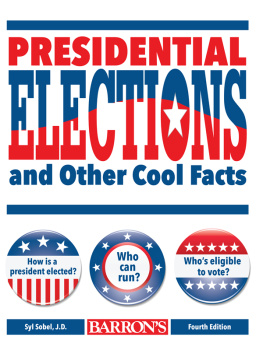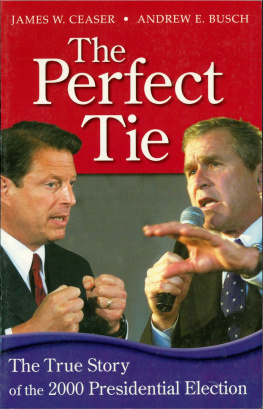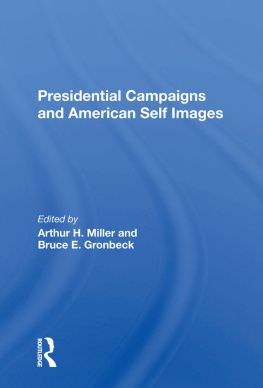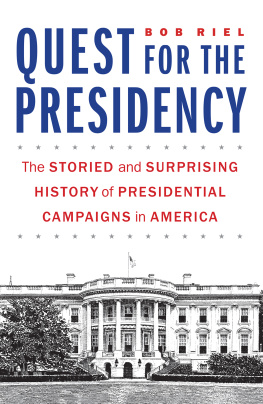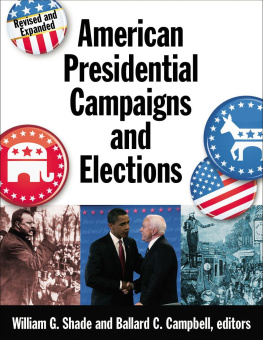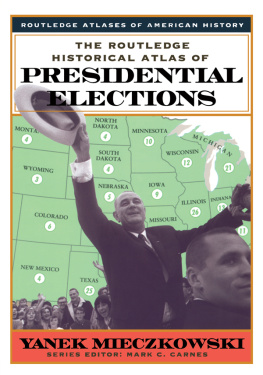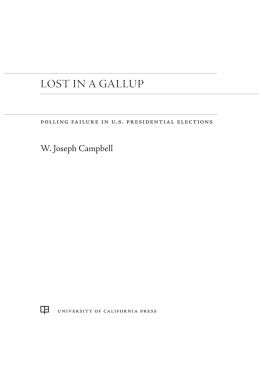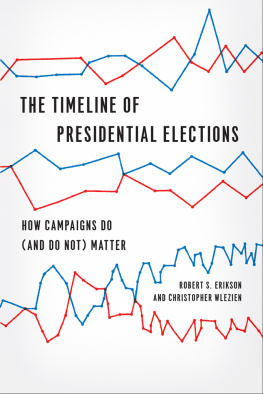

To Izzy, who asked me to write this book.
Copyright 2016, 2012, 2008, 2001, 2000 by Sylvan A. Sobel
Illustrations Copyright 2016, 2012, 2001, 2000 by
Barrons Educational Series, Inc.
All rights reserved. No part of this book may be reproduced or distributed in any form or by any means without the written permission of the copyright owner.
All inquiries should be addressed to:
Barrons Educational Series, Inc.
250 Wireless Boulevard
Hauppauge, New York 11788
www.barronseduc.com
eISBN: 978-1-4380-6829-9
Library of Congress Catalog Card No. 2015953125
Date of Manufacture: December 2015
Manufactured by: Midas Printing International
Tuen Mun, N.T., Hong Kong
Contents
M aybe youve heard grown-ups talking about the presidential election. Maybe youve heard someone say: This is an election year. Or maybe the TV news has stories about people running for president. Did you ever wonder what the presidential election is, and why adults spend so much time talking about it?
You probably know something about elections already. Your school may have a student government or a student council. When you and your classmates vote to put someone from your class in the student government, that is an election. When you and your friends decide whether to play baseball or play with sidewalk chalk, thats an election. An election is when people make choices by voting. Whichever choice receives the most votes wins. A system in which people make decisions by having a vote is called a .

The United States is a democracy. Elections are how the citizens choose who will lead the government. For example, the citizens of your state elect the governor and the other leaders of your state. And the citizens of each state elect their U.S. senators and representatives.
The senators and representatives make the countrys laws in Congress. The leader, or chief executive, of the United States is the president. The presidents job is to make sure the government works properly and that the countrys laws are enforced.
The president is also the commander of our army, navy, and air force. And when leaders of other countries need to meet with the leader of the United States, they meet with the president.
When the citizens elect the president of the United States, they are deciding who will lead the country. That is why the presidential election is so important.

The First Presidential Election Was No Contest
The first presidential election was in 1789. It wasnt really much of an election. George Washington was the only person running for president. He won. The same thing happened in 1792; no one ran against Washington.
Since then, there have been fifty-five presidential elections. In each one, two or more people have tried to be elected president of the United States.
E very election has rules. The basic rules for electing the president are in the . The Constitution is the book of rules that tells our government what its jobs are and how it is supposed to do its work.

The Constitution has several rules about who can be president. They are as follows:
The president must be at least 35 years old.
The president must be a born citizen of the United States.
A person must have lived in the United States for fourteen years to be president.
A person can be president for four years. That four-year period is called a . The Constitution says a person can be elected to only two terms as president.

The Oldest and Youngest Elected Presidents
The oldest person who was elected president was Ronald Reagan. He was 73 years old when he was elected for the second time in 1984. John F. Kennedy was the youngest president ever elected. He was 43 years old when he was elected in 1960.
The Four-Term President!
Originally, the Constitution had no limit on the number of times a person could be elected president. Then, in 1951, the Constitution was changed, or amended, to add a rule that says a person can be elected to only two terms as president.
From the first presidential election in 1789 to the amendment in 1951, only one president was elected to more than two terms. That was Franklin Delano Roosevelt, who was elected president in 1932, 1936, 1940, and again in 1944!

The Constitution also has rules about who can vote in an election. U.S. citizens who are 18 years old or older may vote.
There are also special rules about how to decide who wins the presidential election. In most other elections, whoever gets the most votes wins. But the Constitution creates a special system for electing the president. This system is called the . The electoral college is not a place. Rather, it is a group of people who meet together to elect the president.

T he electoral college involves two elections for president. In the first election, citizens vote for the person they want to be president. These votes are called the . But the person who gets the most popular votes does not automatically win the election.
Instead, people called electors will vote in a second election called the .
The people running for president, called , choose people that they would like to be their electors in each state. The popular vote in each state determines which candidates electors will vote in the electoral vote. In most states, whoever wins the popular votes in a state wins all of that states electors.
For example, lets look at a state that has fifteen electoral votes. Candidate Green and Candidate Brown are running for president. Candidate Brown wins the most popular votes in the state. Thus, the fifteen electors for Candidate Brown become the states electors and will vote for Brown in the electoral vote.

Two states use a different system, however. Maine and Nebraska give two electoral votes to the winner of the states popular vote, and then one electoral vote for each congressional district that each candidate wins.
The number of electors a state has equals the number of its senators plus the number of its U.S. representatives. Every state has two senators. The number of U.S. representatives in a state depends on how many people live in the state. Every ten years the government counts the number of people who live in the United States. This is called a . If more people live in a state than in the last census, the state may get more representatives. If fewer people live in the state than in the last census, or if the state has not gained as many people as other states, it may get fewer representatives.
Next page
